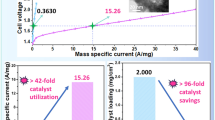Abstract
The development of energy systems based on high specific power hydrogen–air fuel cells using domestic nanostructured materials and technologies is an urgent task. The technologies used for manufacturing proton-exchange membrane fuel cells (PEM FC) by the Russian company BMPower using Pt/C-electrocatalysts of the PM series produced by another Russian company, Prometheus R&D, are presented. It has been shown that, in terms of their functional characteristics, catalysts of the PM series are superior to imported analogues. The use of the PM40 catalyst, as well as other innovative solutions in the field of nanotechnology (nanostructured coatings of bipolar plates, formation of an ionomer on the catalytic layer) makes it possible to achieve a specific power of more than 1 kW/kg in the PEM FC power module with air cooling.








Similar content being viewed by others
Notes
Electrocatalyst with a high loading of PM60 platinum requires the selection of an optimal composition of catalytic ink and a different Nafion/carbon carrier ratio than PM20–PM40 [18]. The electrochemical behavior of this catalyst has not been studied.
Due to the low values of mass activity (Table 2), stress testing of the E-TEK 40 electrocatalyst was not performed.
REFERENCES
Y. Wang, D. F. Ruiz Diaz, K. S. Chen, et al., Mater. Today 32, 178 (2020).
O. Gonzalez-Espasandin, T. J. Leo, and E. Navarro, Sci. World J., 497642 (2014).
R. W. Atkinson, M. W. Hazard, J. A. Rodgers, et al., J. Electrochem. Soc. 164, F46 (2017).
A. Datta and W. Johnson, J. Propuls. Power 30, 490 (2014).
Z. F. Pan, L. An, and C. Y. Wen, Appl. Energy 240, 473 (2019).
S. A. Kirakosyan, A. A. Alekseenko, V. E. Guterman, V. A. Volochaev and N. Yu. Tabachkova, Nanotechnol. Russ. 11, 287 (2016).
A. A. Alekseenko, V. E. Guterman, S. V. Belenov, et al., Int. J. Hydrogen Energy 43, 3676 (2018).
K. Shinozaki, J. W. Zack, S. Pylypenko, et al., J. Electrochem. Soc. 162, F1384 (2015).
D. Van der Vliet, D. S. Strmcnik, C. Wang, et al., J. Electroanal. Chem. 647, 29 (2010).
W. J. Khudhayer, N. N. Kariuki, X. Wang, et al., J. Electrochem. Soc. 158, 1029 (2011).
A. A. Alekseenko, E. A. Moguchikh, O. I. Safronenko, and V. E. Guterman, Int. J. Hydrogen Energy 43, 22885 (2018).
Zh. Xua, H. Zhang, H. Zhong, et al., Appl. Catal. B 111–112, 264 (2012).
O.-H. Kim, C.-Y. Ahn, S. Y. Kang, et al., Fuel Cells 19, 695 (2019).
Z. Li, X. Deng, H. Zhou, et al., J. Solid State Electrochem. 24, 195 (2020).
J. Perez, V. A. Paganin, and E. Antolini, J. Electroanal. Chem. 654, 108 (2011).
F. Godínez-Salomón, E. Arce-Estrada, and M. Hallen-López, Int. J. Electrochem. Sci. 7, 2566 (2012).
Y. Lv, H. Liu, J. Li, et al., J. Electroanal. Chem. 873, 114444 (2020).
S. Martens, L. Asen, G. Ercolano, et al., J. Power Sources 392, 274 (2018).
A. Orfanidi, P. Madkikar, H. A. El-Sayed, et al., J. Electrochem. Soc. 164, F418 (2017).
F. Barbir, PEM Fuel Cells: Theory and Practice (Elsevier, New York, 2005).
B. Millington, S. Du, and B. G. Pollet, J. Power Sources 196, 9013 (2011).
Funding
This work was supported by the National Research University MPEI and the Southern Federal University.
Author information
Authors and Affiliations
Corresponding author
Additional information
Translated by S. Avodkova
Rights and permissions
About this article
Cite this article
Nefedkin, S.I., Guterman, V.E., Alekseenko, A.A. et al. Russian Technologies and Nanostructural Materials in High Specific Power Systems Based on Hydrogen–Air Fuel Cells with an Open Cathode. Nanotechnol Russia 15, 370–378 (2020). https://doi.org/10.1134/S199507802003009X
Received:
Revised:
Accepted:
Published:
Issue Date:
DOI: https://doi.org/10.1134/S199507802003009X




